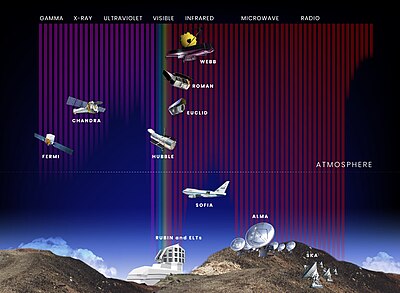Space telescope
This article needs additional citations for verification. (November 2023) |


A space telescope or space observatory is a
History
In 1946, American theoretical astrophysicist Lyman Spitzer proposed to put a telescope in space.[1][2] Spitzer's proposal called for a large telescope that would not be hindered by Earth's atmosphere. After lobbying in the 1960s and 70s for such a system to be built, Spitzer's vision ultimately materialized into the Hubble Space Telescope, which was launched on April 24, 1990, by the Space Shuttle Discovery (STS-31).[3]
The first operational space telescopes were the American
Advantages
Performing
Space-based astronomy is more important for frequency ranges that are outside the optical window and the radio window, the only two wavelength ranges of the electromagnetic spectrum that are not severely attenuated by the atmosphere.[4] For example, X-ray astronomy is nearly impossible when done from Earth, and has reached its current importance in astronomy only due to orbiting X-ray telescopes such as the Chandra X-ray Observatory and the XMM-Newton observatory. Infrared and ultraviolet are also largely blocked.
Disadvantages
Space telescopes are much more expensive to build than ground-based telescopes. Due to their location, space telescopes are also extremely difficult to maintain. The Hubble Space Telescope was serviced by the Space Shuttle, but most space telescopes cannot be serviced at all.
Future of space observatories
Satellites have been launched and operated by
On 16 January 2023, NASA announced preliminary considerations of several future space telescope programs, including the Great Observatory Technology Maturation Program, Habitable Worlds Observatory, and New Great Observatories.[6][7]
List of space telescopes
See also
- Airborne observatory
- Balloon-borne telescope
- Earth observation satellite
- List of telescope types
- Timeline of artificial satellites and space probes
- Timeline of telescopes, observatories, and observing technology
- Ultraviolet astronomy
- X-ray telescope
References
- ^ "Lyman Spitzer - NASA Science". science.nasa.gov. Retrieved 7 January 2024.
- ^ "Hubble Essentials: About Lyman Spitzer, Jr". Hubble Site. Space Telescope Science Institute.
- ^ "Hubble Essentials: Quick Facts". Hubble Site. Space Telescope Science Institute.
- ^ a b "Why a Telescope in Space? - NASA Science". science.nasa.gov. Retrieved 7 January 2024.
- ^ Kaplan, Sarah (18 October 2018). "As NASA's Telescopes Falter, Astronomers Fear Losing Their Eyes In Space". NDTV.com. Retrieved 19 October 2018.
- ^ Foust, Jeff (16 January 2023). "NASA prepares next steps in development of future large space telescope". SpaceNews. Retrieved 24 January 2023.
- ^ O'Callaghan, Jonthan (23 January 2023). "JWST Heralds a New Dawn for Exoplanet Science - The James Webb Space Telescope is opening an exciting new chapter in the study of exoplanets and the search for life beyond Earth". Scientific American. Retrieved 24 January 2023.
Further reading
- Lyman Spitzer, "Astronomical Advantages of an Extra-terrestrial Observatory", 1946
- Neil English: Space Telescopes – Capturing the Rays of the Electromagnetic Spectrum. Springer, Cham 2017, ISBN 978-3-319-27812-4.
External links
 Media related to Space telescopes at Wikimedia Commons·
Media related to Space telescopes at Wikimedia Commons·- Space telescopes with frequencies, at GSFC.

